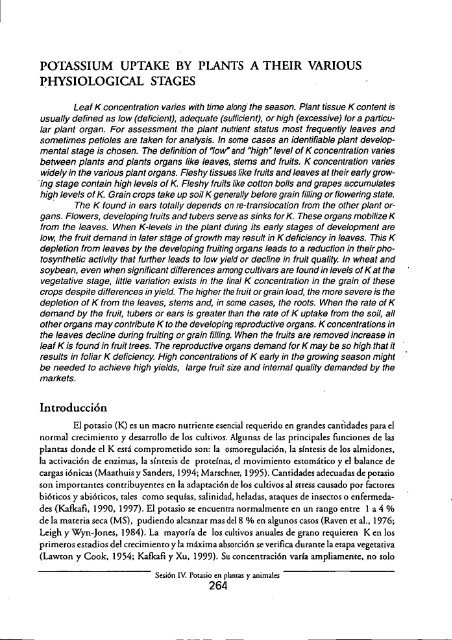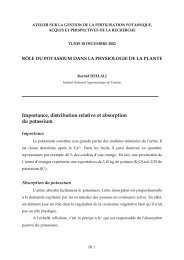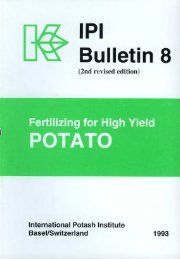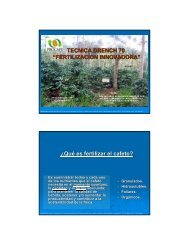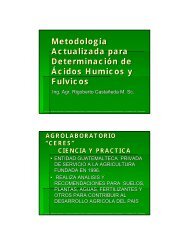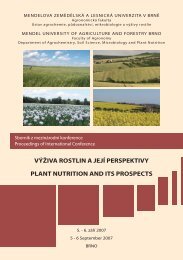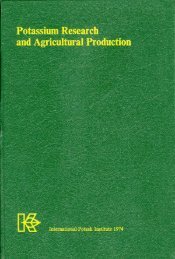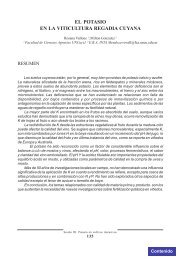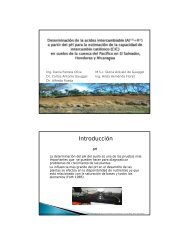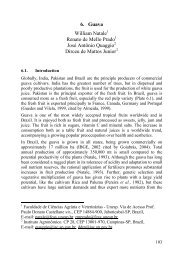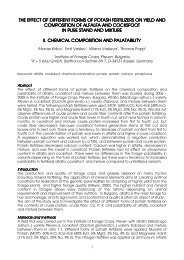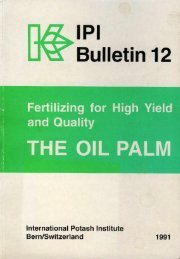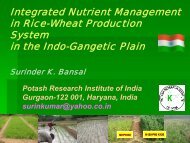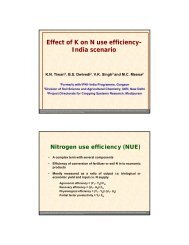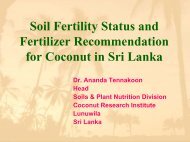Download publication - The International Potash Institute
Download publication - The International Potash Institute
Download publication - The International Potash Institute
You also want an ePaper? Increase the reach of your titles
YUMPU automatically turns print PDFs into web optimized ePapers that Google loves.
POTASSIUM UPTAKE BY PLANTS A THEIR VARIOUS<br />
PHYSIOLOGICAL STAGES<br />
Leaf K concentration varies with time along the season. Plant tissue K content is<br />
usually defined as low (deficient), adequate (sufficient), or high (excessive) for a particular<br />
plant organ. For assessment the plant nutrient status most frequently leaves and<br />
sometimes petioles are taken for analysis. In some cases an identifiable plant developmental<br />
stage is chosen. <strong>The</strong> definition of "low" and "high" level of K concentration varies<br />
between plants and plants organs like leaves, stems and fruits. K concentration varies<br />
widely in the various plant organs. Fleshy tissues like fruits and leaves at their early growing<br />
stage contain high levels of K. Fleshy fruits like cotton bolls and grapes accumulates<br />
high levels of K. Grain crops take up soil K generally before grain filling or flowering state.<br />
<strong>The</strong> K found in ears totally depends on re-translocation from the other plant organs.<br />
Flowers, developing fruits and tubers serve as sinks forK. <strong>The</strong>se organs mobilize K<br />
from the leaves. When K-levels in the plant during its early stages of development are<br />
low, the fruit demand in later stage of growth may result in K deficiency in leaves. This K<br />
depletion from leaves by the developing fruiting organs leads to a reduction in their photosynthetic<br />
activity that further leads to low yield or decline in fruit quality. In wheat and<br />
soybean, even when significant differences among cultivars are found in levels of Kat the<br />
vegetative stage, little variation exists in the final K concentration in the grain of these<br />
crops despite differences in yield. <strong>The</strong> higher the fruit or grain load, the more severe is the<br />
depletion of K from the leaves, stems and, in some cases, the roots. When the rate of K<br />
demand by the fruit, tubers or ears is greater than the rate of K uptake from the soil, all<br />
other organs may contribute K to the developing reproductive organs. K concentrations in<br />
the leaves decline during fruiting or grain filling. When the fruits are removed increase in<br />
leaf K is found in fruit trees. <strong>The</strong> reproductive organs demand for K may be so high that it<br />
results in foliar K deficiency. High concentrations of K early in the growing season might<br />
be needed to achieve high yields, large fruit size and internal quality demanded by the<br />
markets.<br />
Introducci6n<br />
El potasio (K) es un macro nurriente esencial requerido en grandes cantidades para el<br />
normal crecimiento y desarrollo de los cultivos. Algunas de las principales funciones de las<br />
plantas donde el K esti comprometido son: la osmoregulaci6n, la sfntesis de los almidones,<br />
]a activaci6n de enzimas, la sinesis de protefnas, el movimiento estomAtico y el balance de<br />
cargas i6nicas (Maathuis y Sanders, 1994; Marschner, 1995). Cantidades adecuadas de poasio<br />
son importantes contribuyentes en la adaptaci6n de los cultivos al stress causado por f&ctores<br />
bi61icos y abi6ticos, tales como sequfas, salinidad, heladas, ataques de insectos o enfermedades<br />
(Kafkafl, 1990, 1997). El potasio se encuentra normalmente en un rango entre 1 a 4 %<br />
de la materia seca (MS), pudiendo alcanzar mas del 8 % en algunos casos (Raven et al., 1976;<br />
Leigh y Wyn-Jones, 1984). La mayorfa de los cultivos anuales de grano requieren K en los<br />
primeros estadios del crecimiento y la mima absorci6n se verifica durante la etapa vegetativa<br />
(Lawton y Cook, 1954; Kafkafi y Xu, 1999). Su concentraci6n varia ampliamente, no solo<br />
Sesi6n IV. Potasio en plantas y animales<br />
264


